
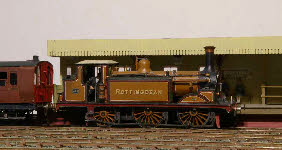


March 2016 to August 2016
Not much activity on the layout for the past few months because I’ve been working hard on finishing a few locos and completing repairs to some of the older ones. However, in testing my engines I’ve been able to identify a few little niggles with the trackwork which I have been able to rectify.
I’ve done some more work on the crossing gates to get them working to my satisfaction - including replacing one of the electronics units which I managed to short-circuit. I’ve also continued with the replacement of Tortoise signal mechanisms with servos. The rotating ground signals are straightforward enough, but the semaphores have proved a little more difficult. A direct drive from the servo arm doesn’t work very well, because the required movement on the signal operating wire is so very small - less than a millimetre. This is only one or two steps of the servo, making the movement very difficult to control.
I’ve opted instead to use a lever mechanism to effectively gear down the servo movement, described in more detail here.
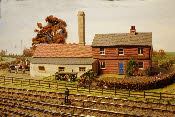
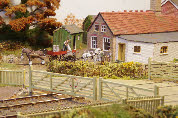 Whilst working on the electronics I’ve also fitted a smoke unit to the creamery chimney, controlled by a MERG timer. That’s prompted me to find and paint a couple of road wagons and some figures to add to the creamery scene.
Whilst working on the electronics I’ve also fitted a smoke unit to the creamery chimney, controlled by a MERG timer. That’s prompted me to find and paint a couple of road wagons and some figures to add to the creamery scene.
Finally we have completed the D&S Sheldon & Cowan crane and its tender.
Next on my list of things to do is to improve the presentation of the layout - additions to the information displays.
September 2016 to January 2017
September and October were spent preparing the layout for the Tyneside Model Railway show - running the layout and improving its operation - trackwork and AJ couplings in particular. The layout ran reasonably well, but some improvement is still required - particularly the fiddle yards. We seemed to have more than our usual number of problems here, caused mainly by poor alignment of the transition track and cassettes. This was probably not helped by my decision to (yet again) relay the transitional tracks, but this time properly ballasted so that transition from scenic baseboard to fiddle yard was rather less intrusive.
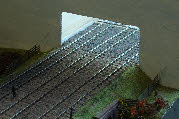
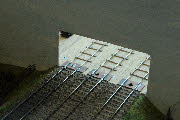 On the left, before, and on the right, after.
On the left, before, and on the right, after.
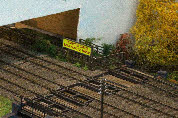 We’ve also added the gate and sign to the private siding for Plumpton Brick and Tile Works. The gate uses yet more MERG electronics -
We’ve also added the gate and sign to the private siding for Plumpton Brick and Tile Works. The gate uses yet more MERG electronics - an EZYpoints driver and servo.
Since the Newcastle show in November I’ve spent most of my time on converting the rest of the signals to servos, to improve their reliability and robustness. I’ve also added the final running signal to the layout - the down home.
Details of how the running signals work is given here, and ground signals are here.
February - December 2017
The first part of the year was spent getting Plumpton ready for Scalefour North - improving running, and making sure all the stock was in good condition. I’m happy to say that all the effort was worthwhile - winning the Walton-Evans trophy for best layout.
After S4N, Plumpton was left in its boxes, while we erected as much of Pulborough in the garage as possible, rewiring most of the boards, and trying to flatten out a couple of the larger boards which have sagged a little over the past 30 years or so (or perhaps were built badly in the first place.......)
Pulborough was well received at the Bluebell show in June - its first outing since 2009, following a very extensive reworking of the scenery, and the rewiring.
Two more shows (Burgess Hill, and Tolworth) kept us busy for the rest of the year
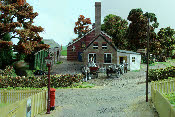
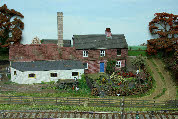 During the year we’ve added a few bushes and trees to the layout, and finished the garden and other detail around the creamery.
During the year we’ve added a few bushes and trees to the layout, and finished the garden and other detail around the creamery.
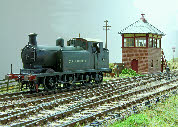 My experiments with 3D printing have yielded results, with the production of the finial to fit on the roof of the signal box -
My experiments with 3D printing have yielded results, with the production of the finial to fit on the roof of the signal box - shown in the photo left. My method is described in detail here.
Perhaps the biggest change has been the removal of AJ’s from all stock and locos. After many years gradually improving the operation of the AJ’s I have finally concluded that I can’t get them to work reliably to my satisfaction for an exhibition layout. They’re ok at home where I can suspend operations for a while so that I can fix something, but at a show this is not sufficient. Things rather came to a head at Scalefour North where my faithful operating team came close to mutiny over their frustration at the occasional problems we had. My reasons for abandoning AJ’s are covered here. They obviously work, or they wouldn’t have lasted so long, but not for me. Over 100 wagons, 60 coaches and 30 locos is just too much to maintain.
Sound is an important part of the railway scene, and the most obvious way forward would be to switch to DCC. However, with a large roster of engines, it would take a long time to convert them all, and I can’t see a halfway-house where I could run a mix of converted and unconverted locos side-by-side. Something for the future perhaps. However, I have, as a compromise, added a sound system with strategically located speakers enabling drivers to whistle during shunting operations, mimicking real-life operation. Details are given here.
Most of the rest of the time between shows has been focused on finishing one engine (High Level Models Black-Hawthorn ), and starting a few others - two Terriers, and two C-class 0-6-0 goods tender engines.
Not much activity on the layout for the past few months because I’ve been working hard on finishing a few locos and completing repairs to some of the older ones. However, in testing my engines I’ve been able to identify a few little niggles with the trackwork which I have been able to rectify.
I’ve done some more work on the crossing gates to get them working to my satisfaction -
I’ve opted instead to use a lever mechanism to effectively gear down the servo movement, described in more detail here.

 Whilst working on the electronics I’ve also fitted a smoke unit to the creamery chimney, controlled by a MERG timer. That’s prompted me to find and paint a couple of road wagons and some figures to add to the creamery scene.
Whilst working on the electronics I’ve also fitted a smoke unit to the creamery chimney, controlled by a MERG timer. That’s prompted me to find and paint a couple of road wagons and some figures to add to the creamery scene.Finally we have completed the D&S Sheldon & Cowan crane and its tender.
Next on my list of things to do is to improve the presentation of the layout -
September 2016 to January 2017
September and October were spent preparing the layout for the Tyneside Model Railway show -

 On the left, before, and on the right, after.
On the left, before, and on the right, after. We’ve also added the gate and sign to the private siding for Plumpton Brick and Tile Works. The gate uses yet more MERG electronics -
We’ve also added the gate and sign to the private siding for Plumpton Brick and Tile Works. The gate uses yet more MERG electronics -Since the Newcastle show in November I’ve spent most of my time on converting the rest of the signals to servos, to improve their reliability and robustness. I’ve also added the final running signal to the layout -
Details of how the running signals work is given here, and ground signals are here.
February -
The first part of the year was spent getting Plumpton ready for Scalefour North -
After S4N, Plumpton was left in its boxes, while we erected as much of Pulborough in the garage as possible, rewiring most of the boards, and trying to flatten out a couple of the larger boards which have sagged a little over the past 30 years or so (or perhaps were built badly in the first place.......)
Pulborough was well received at the Bluebell show in June -
Two more shows (Burgess Hill, and Tolworth) kept us busy for the rest of the year

 During the year we’ve added a few bushes and trees to the layout, and finished the garden and other detail around the creamery.
During the year we’ve added a few bushes and trees to the layout, and finished the garden and other detail around the creamery.  My experiments with 3D printing have yielded results, with the production of the finial to fit on the roof of the signal box -
My experiments with 3D printing have yielded results, with the production of the finial to fit on the roof of the signal box -Perhaps the biggest change has been the removal of AJ’s from all stock and locos. After many years gradually improving the operation of the AJ’s I have finally concluded that I can’t get them to work reliably to my satisfaction for an exhibition layout. They’re ok at home where I can suspend operations for a while so that I can fix something, but at a show this is not sufficient. Things rather came to a head at Scalefour North where my faithful operating team came close to mutiny over their frustration at the occasional problems we had. My reasons for abandoning AJ’s are covered here. They obviously work, or they wouldn’t have lasted so long, but not for me. Over 100 wagons, 60 coaches and 30 locos is just too much to maintain.
Sound is an important part of the railway scene, and the most obvious way forward would be to switch to DCC. However, with a large roster of engines, it would take a long time to convert them all, and I can’t see a halfway-
Most of the rest of the time between shows has been focused on finishing one engine (High Level Models Black-








